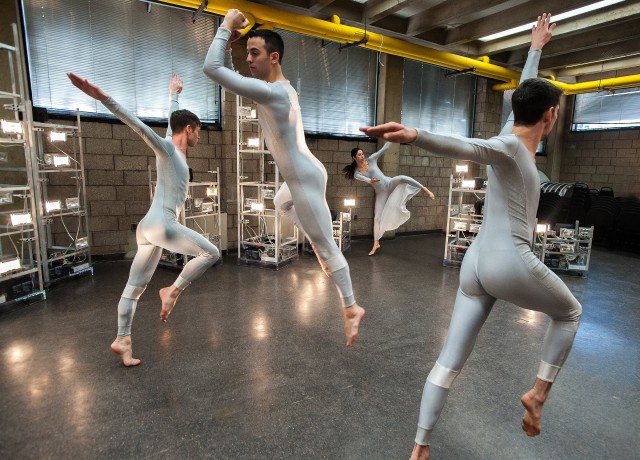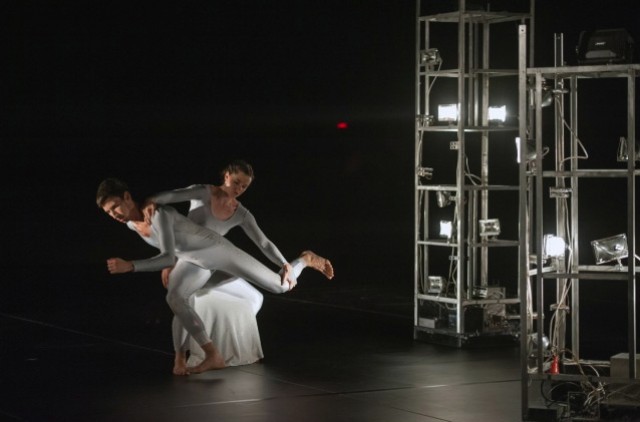
Trisha Brown’s ASTRAL CONVERTED will be performed July 10-14 at the Park Ave. Armory (photo © Stephanie Berger 2012)
Park Avenue Armory
643 Park Ave. at 67th St.
July 10-14, $35-$45, 7:30
212-933-5812
www.armoryonpark.org
www.trishabrowncompany.org
Last year, the Trisha Brown Dance Company celebrated its fortieth anniversary by presenting new works and updated repertory pieces at such locations as the Whitney, the High Line, and, for the first time ever, Dance Theater Workshop. Following a series of open rehearsals, lectures, panel discussions, and children’s workshops on Governors Island as part of the River to River Festival this summer, the company will premiere its latest work, a reconstruction of 1991’s Astral Converted, at another offbeat location, the Park Ave. Armory’s cavernous Ward Thompson Drill Hall, from July 10 to 14. Originally adapted from 1989’s Astral Convertible, Astral Converted features an extraordinary pair of collaborators: Robert Rauschenberg, who designed the set and lighting with Ken Tabatchnik as well as the costumes, and John Cage, who composed the score, which is impacted by motion detectors triggered by the dancers’ movement. The fifty-five-minute Astral Converted is the finale of Brown’s Valiant series, which began in 1985 with Lateral Pass and continued with 1987’s Newark, Astral Convertible, and 1990’s Foray Forêt. In conjunction with the performances, there will be a number of public programs held at the armory, including free screenings July 11-14 at 6:30 of Burt Barr’s 1990 documentary, Aeros, which goes behind the scenes with Brown; the preshow talk “Trisha Brown & John Cage: Seeing the Score” with Julie Martin and Susan Rosenberg on July 10 ($10, 6:00); the postshow talk “Reconstructing Astral Converted” on July 11 with Kristy Edmunds and members of the company and crew (free for ticket holders); the postshow talk “Deconstructing Astral Converted” on July 13 with Neal Beasley and members of the company (free for ticket holders); an onstage master class with company dancer Samuel Wentz on July 14 at 10:00 am ($15 for preregistration, $20 for walk-ins); and an “Astral Artists” family workshop on July 14 (free for ticket holders but advance registration is required).

Samuel Wentz and Megan Madorin go cosmic in beautifully reconstructed ASTRAL CONVERTED (photo by Stephanie Berger)
Update: As Trisha Brown’s reconstructed Astral Converted begins, it appears to have picked up right after the previous exhibition in the massive Wade Thompson Drill Hall, Tom Sachs’s charming “Space Program: Mars.” Robert Rauschenberg’s eight wheeled metal towers, which contain car batteries, headlights, and speakers that are triggered by motion, look like leftover lunar equipment from Sachs’s engaging re-creation, and Rauschenberg’s costumes evoke space suits, although much tighter fitting. Even the dancers’ graceful, elegant, fluid movements recall astronauts floating in zero gravity. And when two of the dancers pick up large brooms, well, it’s as if they’re cleaning up the mess left behind when Sachs unsuccessfully tried to dig up the armory floor / lunar landscape. Set to a dazzling electronic score by John Cage — although on opening night the sound of a photographer snapping away in the balcony during the live performance proved to be rather distracting — Astral Converted is a beautiful piece, fifty-five smooth-flowing minutes of human and mechanical interaction, as the towers are occasionally moved around the stage to provide barriers as well as companionship. The dancers — Patrick Ferreri, Tara Lorenzen, Megan Madorin, Leah Morrison, Tamara Riewe, Jamie Scott, Stuart Shugg, Nicholas Strafaccia, and Samuel Wentz — wait their turn on the dark sidelines, then slither across the black mat and fold their bodies into unusual shapes with an intoxicating gentleness that is reminiscent of some of the movement in Stanley Kubrick’s 2001: A Space Odyssey. Running through July 14 at the Park Ave. Armory, Astral Converted, which made its debut in 1991 in Washington, DC, outside by the Mall, is a wonderfully cosmic experience reconstituted for a terrific indoor location that continues to surprise with its many splendid presentations.